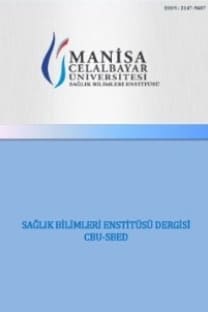Erişkin Hastada Tek Kamera Portu İle Laparoskopik Gastrostomi Post-Operatif Morbidite İlişkili Faktörler ve Sonuçların Açık Gastrostomi Tekniği İle Karşılaştırılması
___
STAMM, M. Gastrostomy by a new method. Med News [Internet]. 1894 [cited 2018 Sep 6];65:324–6. Available from: https://ci.nii.ac.jp/naid/10012182428/Gauderer MW, Ponsky JL, Izant RJ. Gastrostomy without laparotomy: a percutaneous endoscopic technique. J Pediatr Surg [Internet]. 1980 Dec [cited 2018 Nov 1];15(6):872–5. Available from: http://www.ncbi.nlm.nih.gov/pubmed/6780678
Beres A, Bratu I, Laberge JM. Attention to small details: big deal for gastrostomies. Semin Pediatr Surg. 2009;
Georgeson KE. Laparoscopic gastrostomy and fundoplication. Pediatr Ann [Internet]. 1993 Nov [cited 2018 Oct 12];22(11):675–7. Available from: http://www.ncbi.nlm.nih.gov/pubmed/8290324
Buhmann-Kirchhoff S, Lang R, Kirchhoff C, Steitz HO, Jauch KW, Reiser M, et al. Functional cine MR imaging for the detection and mapping of intraabdominal adhesions: method and surgical correlation. Eur Radiol [Internet]. 2008 Jun 15 [cited 2019 Apr 11];18(6):1215–23. Available from: http://link.springer.com/10.1007/s00330-008-0881-5
Park RH, Allison MC, Lang J, Spence E, Morris AJ, Danesh BJ, et al. Randomised comparison of percutaneous endoscopic gastrostomy and nasogastric tube feeding in patients with persisting neurological dysphagia. BMJ [Internet]. 1992 May 30 [cited 2018 Nov 1];304(6839):1406–9. Available from: http://www.ncbi.nlm.nih.gov/pubmed/1628013
Evaristo-Méndez G, Rocha-Calderón CH. Factores de riesgo para neumonía nosocomial en pacientes con cirugía abdominal. Cir Cir [Internet]. 2016 Jan [cited 2018 Nov 1];84(1):21–7. Available from: http://www.ncbi.nlm.nih.gov/pubmed/26259742
Wolkewitz M, Vonberg R, Grundmann H, Beyersmann J, Gastmeier P, Bärwolff S, et al. Risk factors for the development of nosocomial pneumonia and mortality on intensive care units: application of competing risks models. Crit Care [Internet]. 2008 [cited 2018 Nov 1];12(2):R44. Available from: http://www.ncbi.nlm.nih.gov/pubmed/18384672
Baeten C, Hoefnagels J. Feeding via nasogastric tube or percutaneous endoscopic gastrostomy. A comparison. Scand J Gastroenterol Suppl [Internet]. 1992 [cited 2018 Nov 1];194:95–8. Available from: http://www.ncbi.nlm.nih.gov/pubmed/1298056
Mekhail TM, Adelstein DJ, Rybicki LA, Larto MA, Saxton JP, Lavertu P. Enteral nutrition during the treatment of head and neck carcinoma: is a percutaneous endoscopic gastrostomy tube preferable to a nasogastric tube? Cancer [Internet]. 2001 May 1 [cited 2018 Nov 1];91(9):1785–90. Available from: http://www.ncbi.nlm.nih.gov/pubmed/11335904
Alverdy J, Chi HS, Sheldon GF. The effect of parenteral nutrition on gastrointestinal immunity. The importance of enteral stimulation. Ann Surg [Internet]. 1985 Dec [cited 2018 Nov 1];202(6):681–4. Available from: http://www.ncbi.nlm.nih.gov/pubmed/3935061
Deitch EA, Ma WJ, Ma L, Berg RD, Specian RD. Protein malnutrition predisposes to inflammatory-induced gut-origin septic states. Ann Surg [Internet]. 1990 May [cited 2018 Nov 1];211(5):560-7; discussion 567-8. Available from: http://www.ncbi.nlm.nih.gov/pubmed/2111125
Kandil E, Alabbas H, Jacob C, Friedlander P, Duchesne J, Joshi V, et al. A Simple and Safe Minimally Invasive Technique for Laparoscopic Gastrostomy. JSLS J Soc Laparoendosc Surg [Internet]. 2010;14(1):62–5. Available from: http://www.ncbi.nlm.nih.gov/pmc/articles/PMC3021287/
Antoniou SA, Antoniou GA, Koch OO, Pointner R, Granderath FA. Meta-analysis of laparoscopic vs open cholecystectomy in elderly patients. World J Gastroenterol [Internet]. 2014 Dec 14 [cited 2018 Nov 22];20(46):17626–34. Available from: http://www.ncbi.nlm.nih.gov/pubmed/25516678
Antoniou SA, Antoniou GA, Koch OO, Köhler G, Pointner R, Granderath F-A. Laparoscopic versus open obesity surgery: a meta-analysis of pulmonary complications. Dig Surg [Internet]. 2015 [cited 2018 Nov 22];32(2):98–107. Available from: http://www.ncbi.nlm.nih.gov/pubmed/25765889
Van Dusen R, Radomski M, Vaziri K, Amdur R, Knapp S, Sarani B. Comparison of complications following laparoscopic versus open gastrostomy. J Am Coll Surg [Internet]. 2013 Sep 1 [cited 2018 Nov 22];217(3):S14–5. Available from: https://linkinghub.elsevier.com/retrieve/pii/S1072751513005127
Biondi A, Di Stefano C, Ferrara F, Bellia A, Vacante M, Piazza L. Laparoscopic versus open appendectomy: a retrospective cohort study assessing outcomes and cost-effectiveness. World J Emerg Surg [Internet]. 2016 [cited 2018 Nov 22];11(1):44. Available from: http://www.ncbi.nlm.nih.gov/pubmed/27582784
- ISSN: 2147-9607
- Yayın Aralığı: 4
- Başlangıç: 2014
- Yayıncı: Manisa Celal Bayar Üniversitesi Sağlık Bilimleri Enstitüsü
Serebral Venöz Trombozda Trombosit Aktivasyonu ile Rekanalizasyon Süresi İlişkisi
ZEYNEP GİZEM KAYA İSLAMOĞLU, Abdullah DEMİRBAŞ
Atletik Performans ve Spor Genetiği
Nurten DİNÇ, Mehmet Hilmi GÖKMEN
Zeynep Gizem KAYA İSLAMOĞLU, Abdullah DEMİRBAŞ
Pediatri Hemşirelerinin Çocuk Haklarına Yönelik Tutumlarının Belirlenmesi
DİLEK KÜÇÜK ALEMDAR, GAMZE YILMAZ
Kanser hücreleri üzerine Origanum minutiflorum’un Sitotoksik Etkisinin Araştırılması
OKTAY ÖZKAN, CANER ÖZBEY, IŞIL AYDEMİR, İSMAİL SARI, GONCA DÖNMEZ ARAT, Fatma Esi̇n KIRIK, Ahmet SAVRAN, MEHMET İBRAHİM TUĞLU
